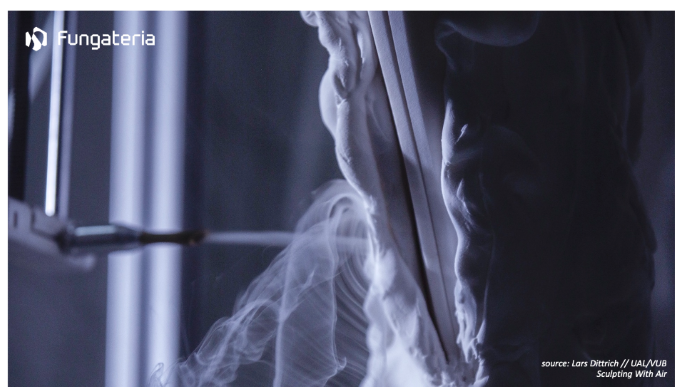EIC - Fungateria
HORIZON-EIC-2021-PATHFINDERCHALLENGES-01
The project FUNGATERIA ‘Enlisting synthetic fungal-bacterial consortia to produce multi-cellular mycelium-based ELMs with computational capability’ will be performed by a consortium of researchers from the Centre for Information Technology and Architecture (CITA) in Denmark, Ghent University, University of Oslo, University of West England, Utrecht University and the Vrije Universiteit Brussel. The project runs for 4 years and focuses on bringing mycelium-based materials into an ‘Engineered Living Material (ELMs)’ context.
Mycelium is the vegetative life form of filamentous fungi, which is abundantly present in natural soil ecosystems. It forms a network-like structure resulting in interesting material-like properties, for example, plastic-, foam- or leather-like, depending on the process conditions under which the organism is grown. In current applications with mycelium-based materials, the fungal organism is killed at the end of the production process. But what if we keep the organism alive during the use of the material? We could imagine that this leads to new functionalities that would completely change a consumer's perception on how to use the product. And how can we engineer such novel functionalities, even taking it beyond the biological capabilities of the fungi in their natural context? These are the questions that the FUNGATERIA project consortium focuses on, by working together in an international and interdisciplinary context.
More specifically, FUNGATERIA sets out to:
- develop a portfolio of mycelium-based ELMs composed of a synthetic co-cultivation consortium comprising a filamentous fungus and a bacterial strain
- develop a modular and generic ELM manufacturing platform called Growth Composing (GC)
- probe the ethical, societal and legislative concerns related to ELM technologies
To this end, synthetic biology engineering will be implemented to use a bacterial strain as a chassis for sensor-containing genetic circuits that render advanced functionalities to the ELM throughout its life cycle, either through direct activity or by influencing the growth and morphology of the fungal partner. ELM activity is verified with probes that reveal bioelectric signalling in the materials - providing additional dimensions of control, monitoring, functionality and exploitation as actively computing devices. When no longer needed or have reached the end of their productive life, kill switches are activated either by human-controlled environmental triggers or triggers of the system itself, thereby causing the ELM to fully and quickly degrade without causing any negative environmental impact.
The metabolic Engineering research group at the Centre for Synthetic Biology of UGent will be responsible for the functionalization of the ELMs. We will develop co-cultivation strategies and reprogram the bacterial partner to add novel spatial-temporal controlled properties to the ELM.
Website
Contact
Prof. Marjan De Mey
Department Biotechnology, Centre for Synthetic Biology
Phone number: +32 9 264 60 28
E-mail
Funding info
Disclaimer
Funded by the European Union. Views and opinions expressed are however those of the author(s) only and do not necessarily reflect those of the European Union or the European Innovation Council and SMEs Executive Agency (EISMEA). Neither the European Union nor the authority can be held responsible for them.


